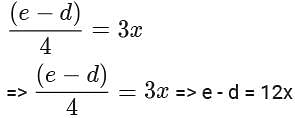Practice Test: Averages - 1 - CAT MCQ
15 Questions MCQ Test - Practice Test: Averages - 1
There are 7 members in a family whose average age is 25 years. Ram who is 12 years old is the second youngest in the family. Find the average age of the family in years just before Ram was born?
The average weight of a class of 10 students is increased by 2 kg when one student of 30kg left and another student joined. After a few months, this new student left and another student joined whose weight was 10 less than the student who left now. What is the difference between the final and initial averages?
| 1 Crore+ students have signed up on EduRev. Have you? Download the App |
The average of 15 numbers is 18. If each number is multiplied by 9, then the average of the new set of numbers is:
The average number of runs scored by Virat Kohli in four matches is 48. In the fifth match, Kohli scores some runs such that his average now becomes 60. In the 6th innings he scores 12 runs more than his fifth innings and now the average of his last five innings becomes 78. How many runs did he score in his first innings? (He does not remain not out in any of the innings)
Dev and Om are among 22 students who write an examination. Dev scores 82.5. The average score of the 21 students other than Om is 62. The average score of all the 22 students is one more than the average score of the 21 students other than Dev. The score of Om is.
There are three persons A, B and C in a room. If a person D joins the room, the average weight of the persons in the room reduces by x kg. Instead of D, if person E joins the room, the average weight of the persons in the room increases by 2x kg. If the weight of E is 12 kg more than that of D, then the value of x is
The average weight of 3 boys Ross, Joey and Chandler is 74 kg. Another boy David joins the group and the average now becomes 70 kg. If another boy Eric, whose weight is 3 kg more than that of David, replaces Ross then the average weight of Joey, Chandler, David and Eric becomes 75 kg. The weight of Ross is:
The mean temperature of Monday to Wednesday was 35 °C and of Tuesday to Thursday was 30 °C. If the temperature on Thursday was 1/2 that of Monday, the temperature on Thursday was ______ .
The average age of a family of 5 members is 20 years. If the age of the youngest member is 10 years, what was the average age of the family at the birth of the youngest member?
The average weight of 10 men is decreased by 2 kg when one of them weighing 140 kg is replaced by another person. Find the weight of the new person.
Manu earns ₹4000 per month and wants to save an average of ₹550 per month in a year. In the first nine months, his monthly expense was ₹3500, and he foresees that, tenth month onward, his monthly expense will increase to ₹3700. In order to meet his yearly savings target, his monthly earnings, in rupees, from the tenth month onward should be
The average weight of a class is 54 kg. A student, whose weight is 145 kg, joined the class and the average weight of the class now becomes a prime number less than 72. Find the total number of students in the class now.
Consider a class of 40 students whose average weight is 40 kgs. m new students join this class whose average weight is n kgs. If it is known that m + n = 50, what is the maximum possible average weight of the class now?
The average of 30 integers is 5. Among these 30 integers, there are exactly 20 which do not exceed 5. What is the highest possible value of the average of these 20 integers?






















